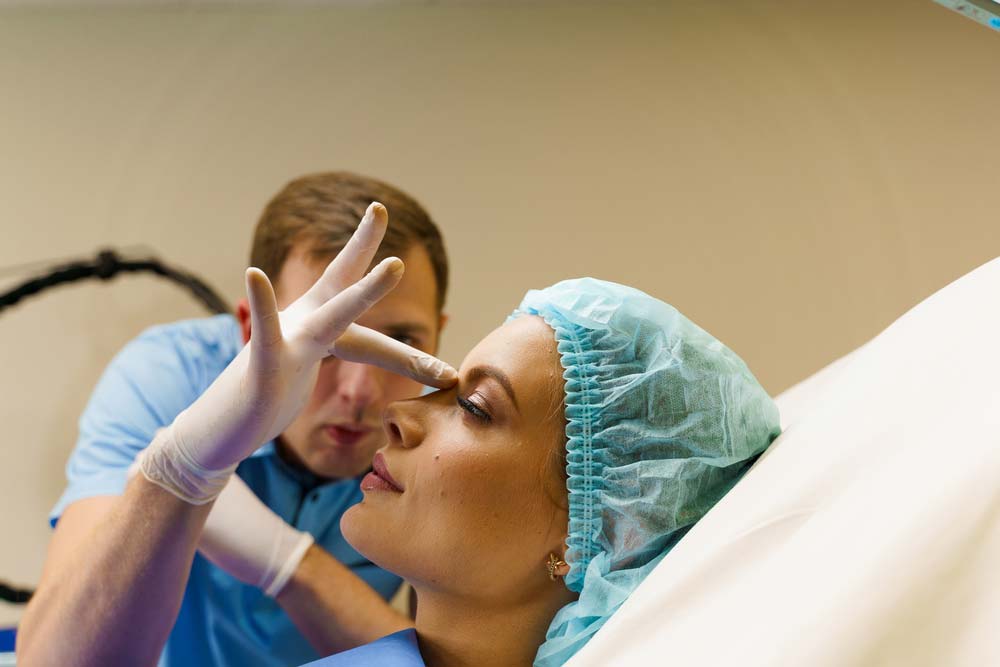Septoplasty in Türkiye
Septoplasty is a surgical procedure to straighten the bone and cartilage (septum) that divides the nostrils, because a deviated septum leads to difficulty breathing and increases the risk of sinus infection. The procedure is based on placing the nasal septum in the middle of the nose after cutting and removing parts of the primary septum.

Why does the nasal septum deviate?
A deviated septum occurs when the septum is bent or tilted to more than one side, and this occurs for reasons including the birth of some people with a deviated septum or an injury that led to it.
Preparing for a septoplasty:
- The doctor may ask to stop taking some medications two weeks before the surgery, such as aspirin, ibuprofen , and blood thinners, to reduce the risk of heavy bleeding during or after the procedure.
- Tell the doctor about any allergy to some medications or if there is any history of bleeding problems.
- Most people undergo the surgery under general anesthesia and in some cases under local anesthesia.
- Stop eating and drinking after midnight the night before surgery. This helps prevent vomiting and choking after anesthesia.
- Bring a family member or friend to help drive the patient home after septoplasty.
- Stop smoking, as smoking increases the risk of problems during and after surgery, and smoking slows down the healing process.
Septoplasty procedure:
Septoplasty takes between 30 to 90 minutes, depending on the complexity of the case. The process begins by making an incision on one side of the nose to reach the septum, then the surgeon lifts the mucous membrane (the protective covering of the septum), then moves the deviated septum to the correct position and removes all What is excess bone or cartilage and finally the mucous membrane is put back in place and stitches are placed to hold both the septum and the membrane in place.
Possible risks of septoplasty
As with any surgery, septoplasty has risks. Bleeding, infection, adverse reaction to anesthesia. Other risks associated with septoplasty are rare, but include:
- Bleeding: In rare cases, severe bleeding may occur, forcing the surgeon to stop the procedure.
- scarring
- Perforated nasal septum: A small hole in the nasal septum can occur during or after surgery.
- Nose shape change.
- Decreased sense of smell.
- Thrombosis in the nose: due to bleeding.
- Temporary numbness in the gums, teeth, or nose: due to injury to the nerves leading to the gums, front teeth, and upper jaw.
- Toxic shock syndrome: This is a very rare and life-threatening infection that requires immediate treatment.
Maintaining nose hygiene and frequent hand washing with antiseptics reduces the risk of infection. The patient may need additional surgery to treat some of these complications. He may also need additional surgery if the result of septoplasty does not meet his expectations.
Recovery from septoplasty:
Septoplasty is performed as an outpatient procedure. This means that the patient is able to go home on the same day as the procedure. Once the effect of the anesthesia wears off, the nose will be swollen, painful and full of cotton. It will be removed one or two days after the surgery. The doctor will prescribe painkillers as needed. And the doctor asks to avoid aspirin, ibuprofen, and other blood-thinning medications to reduce the risk of bleeding problems after the operation. Physical activities should also be limited for several weeks after surgery to reduce swelling and promote healing. This includes strenuous exercises such as running and weight lifting, as these activities increase blood pressure and lead to severe bleeding.
Tips for a speedy recovery include:
- Elevate the head at night to reduce swelling.
- Do not press on the nose for at least three days after surgery.
expectations after the procedure
The wound heals quickly, and breathing improves soon after the procedure. But the overall healing process can be slow as it takes up to a year for the cartilage and other nasal tissues to fully settle into their new shape. Most people do not experience persistent symptoms after surgery. However, in some cases, the cartilage and nasal tissues continue to shift over time and eventually block the flow of air through the nose again, which means that a second surgery is needed to reshape the nose and septum.
How can I book a septoplasty in Türkiye?

- Free medical support on the phone: You will have a dedicated representative for your health condition who is always ready to answer your questions.
- Free consultation with a specialist doctor: Your medical representative will consult with a number of doctors and hospitals to find the best possible treatments.
- Free travel visa arrangement: We will contact the embassy in your country to assist you in obtaining a visa to visit Türkiye.
- Free itinerary planning: We will create a schedule for your medical trip to Türkiye.
- Free translation of documents and reports: We will translate medical documents and reports into Turkish on your behalf.
- Free support and monitoring: We will monitor the stages of treatment and be by your side every step of the way.
- Free instant translation: We will be with you during the treatment stages to provide translation between you and the medical team.
- Free accommodation and transportation coordination: We will book accommodation for you and your companions in Türkiye, along with transportation services.
Contact REHABTÜRK doctors for more information about the procedure and to evaluate your medical condition.
